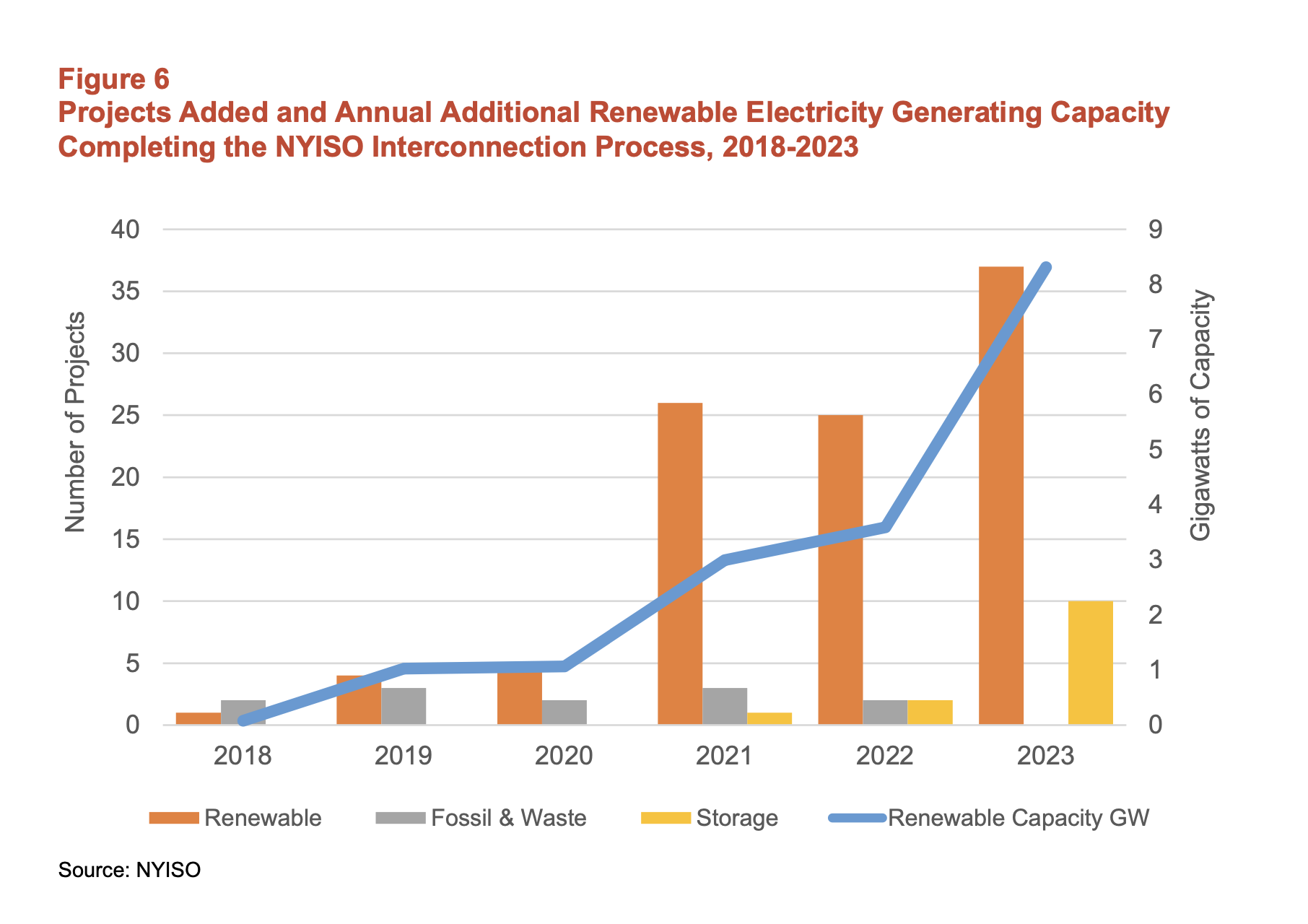New York State has a lot of work to do if it hopes to meet the transmission requirements outlined in the 2019 Climate Leadership and Community Protection Act (CLCPA).
A report by The Office of the New York State Comptroller (NYSOSC), currently led by Thomas P. DiNapoli, states that as of 2022, renewables accounted for approximately 29% of the electricity generated in the state came from renewable sources, of which roughly 75% came from hydroelectric generation, with the remaining 25% primarily split between wind and solar. In 2019, New York State adopted the Climate Leadership and Community Protection Act (CLCPA), which including goals of generating 70% of electricity used from renewables by 2030;installing 6 GW of distributed solar by 2025; installing 3 GW of storage by 2030, and more.
An analysis by the NYISO found that to meet the CLCPA 2030 renewable electricity goal, the state will have to more than triple the installed 2022 renewable capacity of roughly 6.5 GW by adding an additional 20 GW over an 8-year period.
The NYSOSC report names three interrelated processes that play a role in the development of renewable electric generation resources in the state. The processes work in parallel and developers should note that they do not need to have completed any of the processes before they can enter one of the other processes. Permitting and grid interconnection, however, are required for any all-new sources of generation.
The three processes are incentives, permitting and siting and interconnection. Through various programs, particularly renewable energy certificates (RECs), incentives stimulate the market to advance the state toward its renewable goals. The report notes that the permitting process is intended to ensure that projects are sited in areas and under conditions consistent with state and local laws and regulations. The interconnection process should ensure sufficient electric transmission and distribution infrastructure to satisfy customer demand. The report suggests that streamlining the three parallel processes can help reduce the frequency of slow-moving or canceled projects. This is essential, the report contends, to ensuring the state will meet its goal of removing greenhouse gasses from the grid by 2040.
According to the report, there were three key challenges that hindered its progress: inconsistent provision of incentives; project cancellations; and lengthy project timelines due to delays in siting and operationalization.
The funding for projects varied widely, too: from $400 million to finance two procurements in 2011 to $66 million in 2013. This irregularity resulted in slow progress, preventing the state from meeting renewable electricity goals outlined in the RPS.
The NYSOSC report suggests funding commitments increased under New York’s CES from $360 million in 2016 to $1.4 billion in 2017, leading to more projects under contract. NYSERDA indicates that if the current pipeline of developments is finished, they will provide 66% of New York’s projected electricity needs.
Decreasing project timelines
Delays in siting and operationalization are the primary cause of slow project timelines, the report contends.
According to the New York League of Conservation Voters Education Fund, only one renewable electricity generation project has been approved through Article 10 of the New York State Public Service Law since the end of 2018.
The formation of ORES in 2020 has shortened approval times. The department has 60 days to determine an application’s completeness and a one-year limit to issue a final permit. NYSOSC suggests this new approach has helped to expedite some projects, “Since June, ORES has permitted 13 renewable electric generating facilities, totaling 2.1 gigawatts of generation capacity.”
However, the office still needs a secure vetting process to prevent permitting and interconnection irregularities in the future.
Reforms to the interconnection process overseen by NYISO include shortening the time it takes the organization to assess the impacts of a proposed renewable electric facility on the state’s transmission grid. Between 2018 and 2022, NYISO was one of four independent system operators with over three year wait times, the longest in the country.
However, in 2023, projects with over 8 GW of renewable capacity, including two of the state’s offshore wind projects, completed the NYISO interconnection process. The organization has 457 developments in its interconnection queue, but the dramatic increase in projects pushed through this year leaves NYSOSC hopeful.

Other challenges the State must address to remove greenhouse gasses from its electric grid by 2040 include building new electric transmission infrastructure to accommodate state-wide renewable electricity and being transparent with consumers about the increase in utility bills.
New York already has the 10th highest domestic electricity costs. However, the state is looking to lower these through community solar programs and bill credits. Regarding expanding electric transmission grids, The New York State Public Service Commission (PSC) has included proposals to address this in NYSOSC’s report.
This content is protected by copyright and may not be reused. If you want to cooperate with us and would like to reuse some of our content, please contact: editors@pv-magazine.com.








By submitting this form you agree to pv magazine using your data for the purposes of publishing your comment.
Your personal data will only be disclosed or otherwise transmitted to third parties for the purposes of spam filtering or if this is necessary for technical maintenance of the website. Any other transfer to third parties will not take place unless this is justified on the basis of applicable data protection regulations or if pv magazine is legally obliged to do so.
You may revoke this consent at any time with effect for the future, in which case your personal data will be deleted immediately. Otherwise, your data will be deleted if pv magazine has processed your request or the purpose of data storage is fulfilled.
Further information on data privacy can be found in our Data Protection Policy.